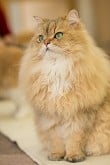
Cats are found all across the world, but those with Asian ancestry have a few unique traits. Discover the breeds of Asian cats.
The names of several of the most popular Asian cat breeds are derived from the original breeding locations of the animals. For instance, the elegant and gentle Siamese breed originated in—you guessed it—Siam. The largest continent is home to some of the most elegant-looking cats. Asian cat breeds can be ideal for you if you’re looking for a housepet that’s particularly stunning, unique, and a little posh.
PERSIANS CAT
One of the oldest and most well-liked breeds of domestic house cats is the Persian. They belong to the breeds with the fluffiest long hair. They have a reputation for being amiable and laid back. Persian cats are popular for a good reason—they’re wonderful companions. If you’re willing to maintain a closet full of lint-removing materials, that is. Persians have a reputation for shedding a lot.
Characteristics
This breed is known for its beautiful, long coat and its sweet, gentle temperament. Persians are affectionate and intelligent cats, and they love to spend time with their human companions. They’re also known for being quiet and laid-back and they are not overly demanding of attention.
Disease
While Persians cats are generally healthy cats, there are few health issues that are more common in this breed. One of the most common health issues is polycystic kidney disease, or PKD. Persian can also be prone to respiratory issues, eye issues, and bladder issues. It’s important to find a reputable breeder who tests for these issues and provide health guarantees.
Grooming
The beautiful, long coat of the Persian cat require regular grooming and care. Persians should be brushed at least a few times a week, and they can need more frequent brushing during shedding season. They should also have their nails trimmed regularly and their ear cleaned. It’s also important to keep their eyes clean and free from discharge. With regular grooming and care, you can help keep your Persian looking and feeling it’s best.
SIAMESE CAT
The Siamese breed, renowned for its silky, short hair and blue eyes, has been adored for ages. However, their beauty extends beyond their appearance. It’s commonly known that Siamese cats are outgoing and amiable.
Personality
Siamese cat is another popular breed, and it’s known for it’s unique look and personality. Siamese cats have striking blue eyes and a distinctive coat pattern, and they’re also known for being vocal and chatty! They’re intelligent, playful, and curious, and they love to be around their human companions.
Disease
Though they are mostly healthy, there are a few health issues to be aware of. Some common heath issues include hip dysplasia, a condition that affects the hips and cause pain and stiffness. Siamese cats can be prone to feline asthma, a respiratory condition that cause coughing and difficulty breathing. In addition, Siamese cats can be prone to a condition amyloidosis, which is a disease that affects the kidney.
Grooming
They are known for having low maintenance coat. They have a short coat that doesn’t require a lot of brushing, and they’re also known for being fastidious groomers and keeping themselves clean. That being said, they still need regular nail trims and occasional baths. They also need to have their ears checked regularly for signs of infection.
BENGALI FELINES
Bengals, whether spotted or marbled, resemble exotic jungle creatures rather than cuddly house pets. Another peculiar quality of Bengals is their fondness of water play and wild appearance with affectionate personality. Bengals have a spotted or marbled coat that resemble a leopard, and they’re also known for being very athletic and active.
Disease
Bengals can be prone to certain health issues. One of the most common health issues of Bengals is hypertrophic cardiomyopathy, a heart condition that can cause difficulty breathing and sudden death. They can also be prone to hip dysplasia, a joint condition that can cause pain and stiffness. Another common issues for Bengals is progressive retinal atrophy, a genetic eye disease that can lead to blindness. But regular vet checkups and proper care, Bengals can live long and healthy lives.
Grooming
Bengals have short, low-maintenance coat, they still require some grooming. They should be brushed regularly to remove loose hair and prevent matting. Bengals also need their nails trimmed, and they should have their ears cleaned and their teeth’s brushed regularly. They also need regular veterinary checkups to monitor their health and identify any potential issues early on.
ORIENTAL SHORTHAIR
Oriental shorthairs are colorful on the inside as well as the outside, with big personalities (and big ears) and an outgoing, playful nature. They resemble Siamese cats of a different color, and were actually bred for this exact reason, to give their ancient owners more options.
Characteristics
Oriental is a breed that is closely related to the Siamese, and it has many similar characteristics. It’s known for its short, glossy coat, large ears and long, lean body. Like the Siamese, the Oriental short hair is intelligent, active, and vocal. They’re also known for being extremely loyal and affectionate towards their human companions.
Grooming
The Oriental short hair has a short, glossy coat that requires minimal grooming. They should be brushed or combed once or twice a week to keep their coat healthy and shiny. They also need their ears and teeth cleaned regularly. Unlike other breeds, the oriental shorthair doesn’t require frequent baths unless they get especially dirty or smelling.
Disease
Oriental shorthair are prone to some health issues, like many other cats, they can be to hypertrophic cardiomyopathy, a heart condition that can cause difficulty in breathing. They are also susceptible to progressive retinal atrophy, a genetic eye disease that can cause blindness. Other common health issues include, respiratory problems and urinary tract problems.
Burmese Cat
Burmese cats are also known as the BURMILLA, they are lovely and endearing, with enticing almond-shaped eyes that make them excellent friends. Burmese cats have a reputation for accompanying their owners on short errands or dog walks. Their coats are velvety smooth, come in a range of colors, and require nothing in the way of human grooming.
Personality
Burmese cat is known for having a friendly, affectionate personality. They’re often described as “velcro cats” because they love to be close to their human companions. They’re also intelligent and curious, and they often like to play games and learn tricks. They are known for being very social and getting along well with other pets and children.
Disease
The Burmese cats is generally a healthy breed, but they can be down to some health issues. One of the most common health problems for Burmese cats is gingivitis, or inflammation of the gums. They can also be prone to urinary tracts problems and polycystic kidney disease. They should be regularly screened for these and other health issues to ensure they remain happy and healthy.
Grooming
The Burmese cat has a short coat that’s easy to care for. They should be brushed or combed once or twice a week to remove loose hair and keep their coat shiny and healthy. They should also have their nails trimmed regularly and their ears cleaned once a week. Their teeth should be brushed once a week to prevent gingivitis and other oral health problems.
KORAT FELINES
It is thought that Korat cats, with their unusual shimmering silver-blue coats, are native to Siam and unique personality. The korat are often called the “good luck” cats. They have a reputation for being kind, perceptive, and intellectual friends. Korats are rather easy to teach, in contrast to many other cat breeds.
Characteristics
The Korat is a medium-sized cat with long, slender body. They have a short, dense coat that’s blue-grey in color and has a lustrous sheen. They have large, round eyes that are usually green or yellow-green in color. Their ears are large and pointed, and their tails are long and slender. They have a gentle, quite voice, and they’re known for being especially good at mimicking human speech.
Disease
The korat is also a healthy breed, but they can be prone to some health issues, including:
• Polycystic kidney disease
• Hypertrophic cardiomyopathy
• Patellar luxation (dislocation of kneecap)
• Upper respiratory infections
It’s important to take your Korat to the vet regularly for checkups and to make sure they’re up to date on their vaccinations.
Grooming
They don’t require much, their short, dense coat doesn’t require much brushing once or twice a week should be sufficient. They should have their nails trimmed regularly, and their ears should be checked and cleaned once a week. Their teeth should be brushed at least once a week to prevent dental disease. And also they should be given plenty of love and affection.










